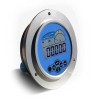Pressure data loggers for demanding hydraulic test applications. Verify performance, reliability, and safety of actuators, pumps, valves & systems.
Pressure data loggers specifically designed for hydraulic testing are essential tools for engineers and technicians needing to capture detailed pressure information during system and component evaluation. These instruments go beyond simple gauges, recording high-speed pressure transients, variations over extended cycles, and precise profiles necessary for validating performance against design specifications, ensuring operational reliability, diagnosing faults in components like actuators, valves, and pumps, and confirming compliance with safety standards in demanding applications from R&D labs to production lines and field maintenance.
 DM01-500-HD High Range Digital Pressure Gauge - The DM01-500 HD high range pressure gauge is available in pressure ranges from 0 to 600, 1000, 1600, 2000 & 2200 bar.
DM01-500-HD High Range Digital Pressure Gauge - The DM01-500 HD high range pressure gauge is available in pressure ranges from 0 to 600, 1000, 1600, 2000 & 2200 bar. ADT681 Digital Pressure Gauge - The ADT681 digital pressure gauge family covers a wide range of pressures from as low as 1 inH20 differential to as high as 36,000 psi gauge.
ADT681 Digital Pressure Gauge - The ADT681 digital pressure gauge family covers a wide range of pressures from as low as 1 inH20 differential to as high as 36,000 psi gauge.
Find out more about Hydraulic Testing Pressure Data Loggers to determine which product options and capabilities will best meet your application requirements.
Pressure data loggers engineered for hydraulic testing applications provide crucial insights beyond simple peak pressure readings, enabling detailed analysis of system and component behaviour under operational stress. These instruments are indispensable for capturing dynamic pressure fluctuations, transient events, and long-term trends during rigorous test cycles designed to verify reliability, performance, and safety compliance in hydraulic circuits. Engineers and technicians rely on this stored pressure data to validate designs, diagnose faults, and confirm adherence to specific operational parameters and tolerances.
The demands of hydraulic testing necessitate data loggers with specific capabilities. Capturing rapid pressure spikes generated during valve actuation, pump start-up, or potential hydraulic shock (water hammer) requires high sampling rates, often significantly faster than those needed for static or slowly changing processes. Furthermore, the ability to record pressure profiles over extended periods, such as during endurance or fatigue testing of actuators or hydraulic motors, demands substantial onboard memory capacity to store large datasets without interruption. Analysis of this time-stamped data allows for precise characterization of component response times, pressure decay rates during leak testing, or consistency across thousands of operational cycles.
Specific applications highlight the utility of pressure data logging in hydraulic component verification. When testing actuators, logging pressure alongside position or force can verify performance curves and identify issues like seal bypass or sticking. For hydraulic valves, loggers capture pressure drops during flow, response times to control signals, and can help quantify internal leakage rates under sustained pressure. Evaluating pump performance involves logging output pressure against flow rate or drive speed to map efficiency curves and detect anomalies like pressure ripple. Similarly, testing hydraulic presses requires consistent pressure application, which data loggers can verify cycle-after-cycle, while logged data from hydraulic weighing pads confirms calibration accuracy and load distribution.
These specialized loggers are frequently deployed in demanding environments, ranging from research and development labs refining new component designs to manufacturing facilities performing end-of-line quality control checks on assembled hydraulic systems. Dedicated test benches simulating specific operational conditions for components like pumps, motors, or cylinders heavily utilize pressure data logging for performance validation. Field service and maintenance technicians also employ portable pressure loggers for on-site troubleshooting of construction machinery, industrial presses, or aerospace hydraulic systems, helping to pinpoint intermittent faults or verify system health after repairs. The logged data provides objective evidence for compliance reports, failure analysis, and system optimization efforts. The ability to trigger logging based on specific pressure thresholds or external events further enhances their utility in capturing specific moments of interest during complex test sequences.
